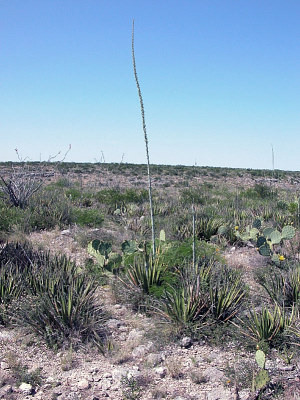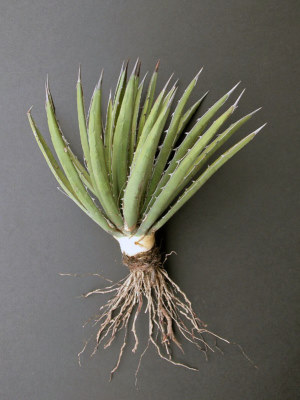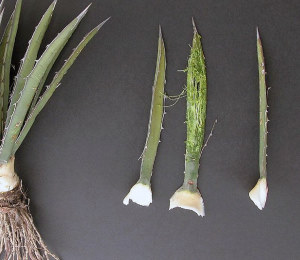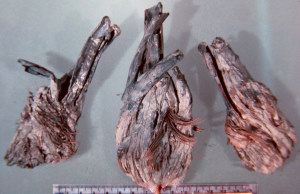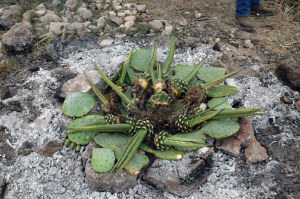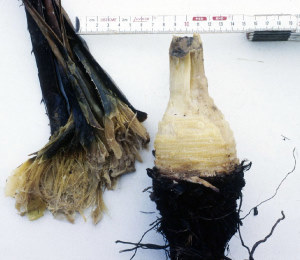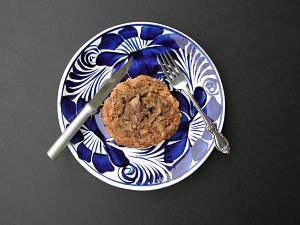Lechuguilla
Agave lechuguilla
Agavaceae Family
This small agave was literally and figuratively woven into the fabric of native life in the Lower Pecos Canyonlands and presents an extraordinarily important natural resource. Native peoples used the entire lechuguilla plant, including the leaves, central stem, and flower stalk, for many different purposes.
Lechuguilla leaves and leaf fibers were used to make mats, sandals, cord, baskets and more. The raw sap is useful as a detergent, as a fish-killing poison, and as an arrow-tip poison. Its tall flower stalks were used for dart shafts and other tools, as well as for firewood. The heart, or pulpy central stem with attached leaf bases, was baked for 48 hours and then pounded and formed into sweet chewy patties that could be dried and stored for months, much like sotol. Lechuguilla, however, is a much less bulky plant than sotol and can be easily harvested and processed more efficiently, making it a more important food source.
Lechuguilla is one of the most widespread of the agaves, and grows from southeastern New Mexico to southward to the southern state of Hidalgo in Mexico. This small agave grows densely on rocky slopes and surfaces in the lower elevations of the Chihuahuan Desert. In Texas, lechuguilla grows from El Paso eastward to the West Nueces River in Edwards County in the southwestern corner of the Edwards Plateau. See Cheatum et al. (1995) for a very detailed account of the uses and distribution of lechuguilla and other members of the genus Agave in Texas and adjacent regions.
Like most agaves, sotol, and yucca, lechuguilla is an evergreen rosette: the well-armed leaves are arranged in spiral ranks around a thick, shortened stem. The plant stores most of its carbohydrates in the fleshy but fibrous central stem, which also contains saponins, a combination of steroids and sugars, that foam when water is added to the sap and agitated (Nobel 1994). One of the saponins has been identified as smilogenin, and lechuguilla contains more of it than any other agave (Gentry 1982:136). The detergent property of the saponins makes lechuguilla sap an effective soap (Pennington 1963:212), but when taken internally, the same property damages animal cells; hence the plant is considered toxic. The Tarahumara Indians of Chihuahua, Mexico, understood this property and would pound the central stems and leaves of the plants and throw them into water holes of small streams. The sap shocked the fish, bringing them to the surface over several hundred yards along the streams (Pennington 1963:105).
Archeological occurrence. The archeological deposits of the dry rockshelters in the Lower Pecos Canyonlands contain more lechuguilla plant fragments than perhaps any other single resource. For instance, countless cut leaf bases, central stem fragments, quids, flower stalks, and leaf fragments were recovered from the deposits at Hinds Cave. Lechuguilla fiber is part of many perishable artifacts from the area.
Weaving and other uses of fiber. When green lechuguilla leaves are pounded, the plants fibers can easily be separated and used for weaving and sewing. In Mexico, the fibers of lechuguilla are known as ixtle, a term also applied to the fibers of other agave and yucca species. The strong lechuguilla fibers are used to fashion rope as well as brushes, and a cottage industry that separates the fibers for rope production survives in northern Mexico to this day. This modern usage of lechuguilla fiber pales by comparison to its documented uses in the Lower Pecos Canyonlands. Lechuguilla fiber was used to make cord, rope, nets, baskets, sandals and more. Any time a strong fiber, similar in strength to what is known today as carpet thread, was needed, lechuguilla could be used. At Hinds Cave, fragments of lechuguilla (and yucca) cordage or rope were found in almost every bucket of excavation fill that archeologists screened.
Food: As a food source, lechuguilla was sought out for the carbohydrates contained in the central stem and attached lower leaf bases, sometimes referred to collectively as the heart. The heart of the plant is rich in carbohydrates, but these are very complex, long-chain sugars that must be broken down by prolonged heating (baking) before they are edible. The baking is also needed to break down the toxic sap. Native peoples baked lechuguilla in earth-covered cooking pits known as earth ovens.
Although lechuguilla can be harvested and baked any time of the year, the maximum amount of sugars are present during wet periods just prior to the time a mature plant sends up its flower stalk. The sugars are, in effect, stored energy that the plant draws on to flower. During droughts the plant is stressed and contains little sugar relative to toxic compounds and fiber. After sending up its flower stalk, the plant’s energy is spent and it usually dies. Because it can take up to 30 years for a plant to mature, lechuguilla stands can be easily over harvested, especially if smaller, less ideal plants are removed out of desperation or for non-food use. Heavily harvested stands may take several decades to recover.
To harvest the plant, a strong hardwood digging stick or modern equivalent must be used to pry up the tenacious plant or sever the central stem from the roots. Given its preferred rocky habitat, this requires expertise or lots of persistence. Once the plant is removed from the ground, the leaves are trimmed off close to the central stalk with a sharp stone or metal knife. Only the leaf bases (the part that attach to the stem) are potentially edible. Once cooked, the trimmed leaves are eaten somewhat like an artichoke leaf, albeit a very tough, chewy artichoke leaf.
Once trimmed lechuguilla stalks are amassed, they are cooked in a 5-step process in an earth oven.
1) Prepare abroad, shallow pit with sloping walls (about 20-24 inches deep by 5 to 7 feet wide). Loosely stack approximately 450 pounds of wood (branches) and place 515 pounds of large rock into the wood. (See Oven Sequence 1 and 2)
2) Let it burn until only hot coals are left. By now the heat has been transferred from the burning wood to the rocks, which act as a heating element. (Oven Sequence 3)
3) The exposed rocks are VERY HOT, about 700-900° F, and VERY DANGEROUS. Place the green packing material, consisting of prickly pear pads, on the hot rock heating element; this has to be done QUICKLY, or the prickly pear pads will burst into flame. The prickly pear pads contain lots of water and oxalic acid. When heated, the pads provide steam and a mild acid that helps to break down the toxins in the lechuguilla plants. Put the trimmed lechuguilla on the packing material (Oven Sequence 4)
4) Cover the food with prickly pear pads, leaves or a mat, then cover everything with a thick layer of dirt, making certain that the oven is completely sealed. (Oven Sequence 5)
5) Open the oven after waiting 48 hours, remove the cooked lechuguilla, (which now smells like molasses), chew wads of leaf bases, pound the stems into pulp and shape into flat cakes. Dry the cakes in the sun. (Oven Sequence 6-8).
References:
Cheatham, Scooter, Marshall C. Johnson, and Lynn Marshall
1995 The Useful Wild Plants of Texas, the Southeastern and Southwestern United States, the Southern Plains, and Northern Mexico, Volume 1. Useful Wild Plants, Austin, Texas.
Gentry, Howard S.
1982 Agaves of Continental North America. University of Arizona Press, Tucson, Arizona.
Nobel, Park S.
1994 Remarkable Agaves and Cacti. Oxford University Press, Oxford, UK.
Pennington, Campbell W.
1963 The Tarahumara of Mexico: Their Environment and Material Culture. University of Utah Press, Salt Lake City, Utah.
![]()
